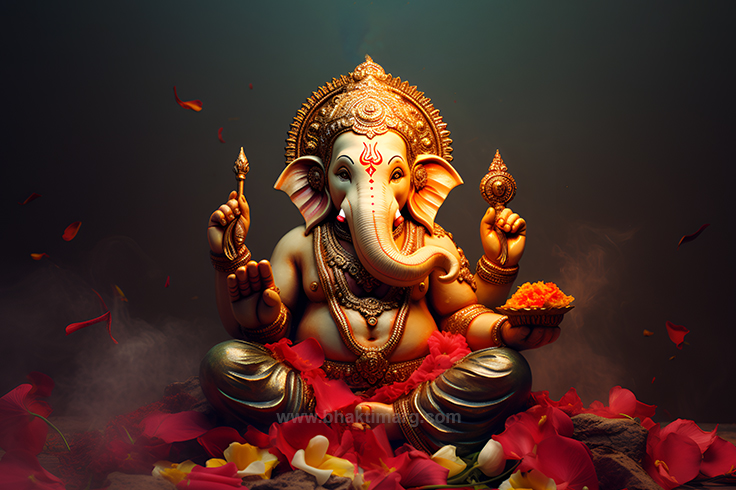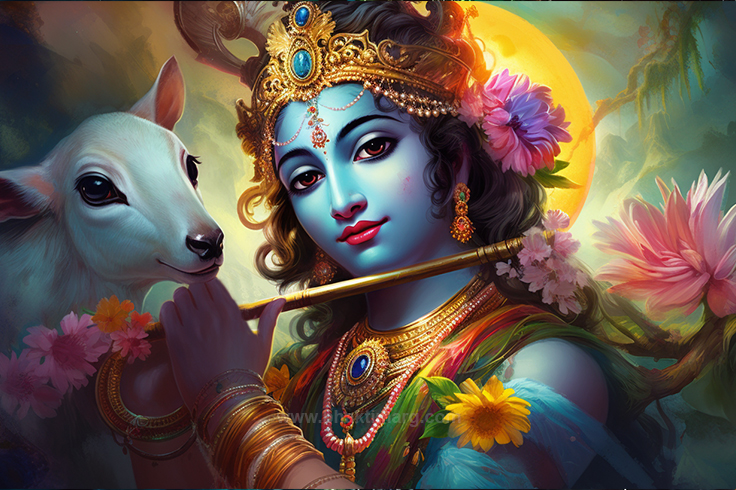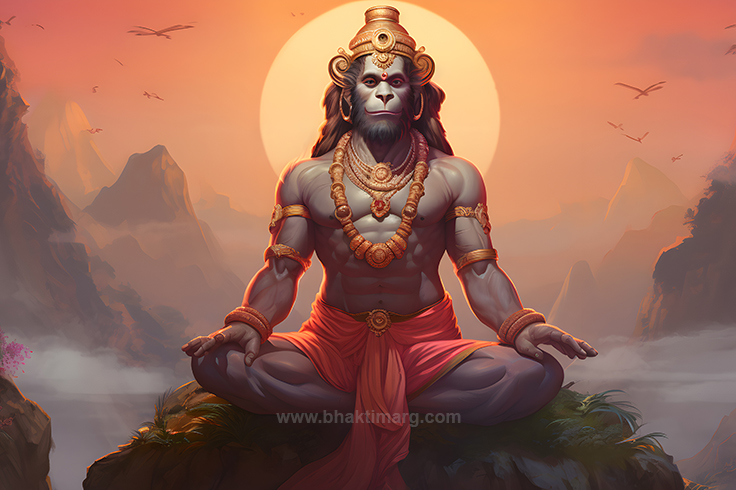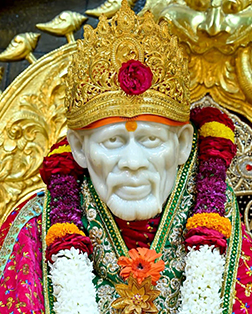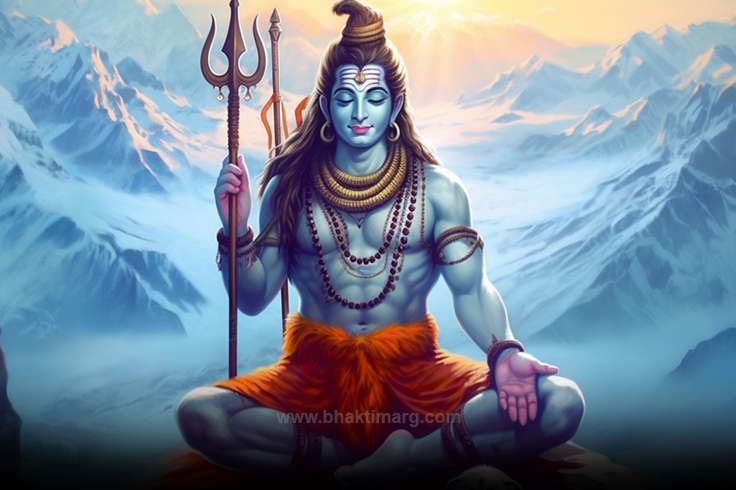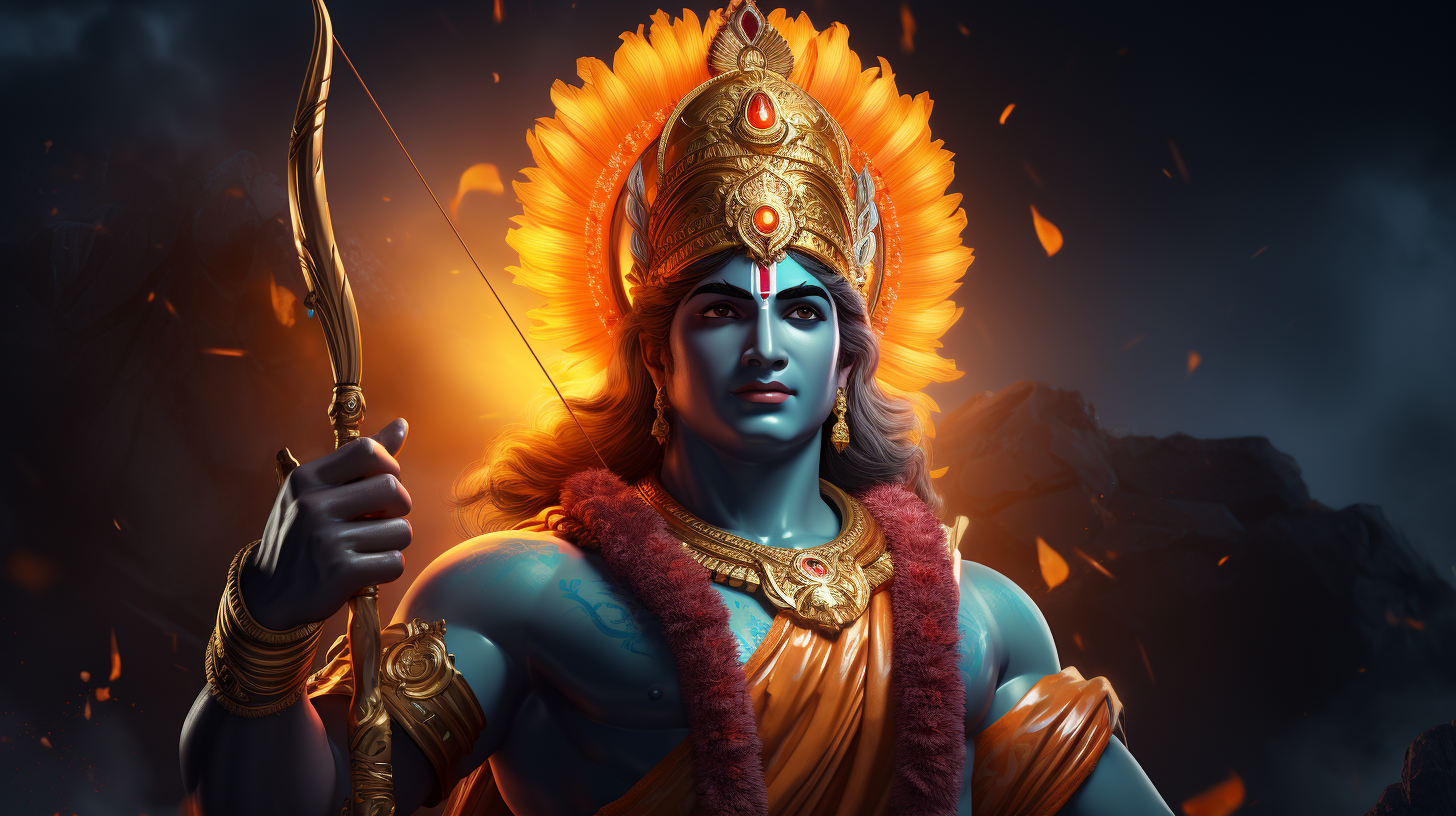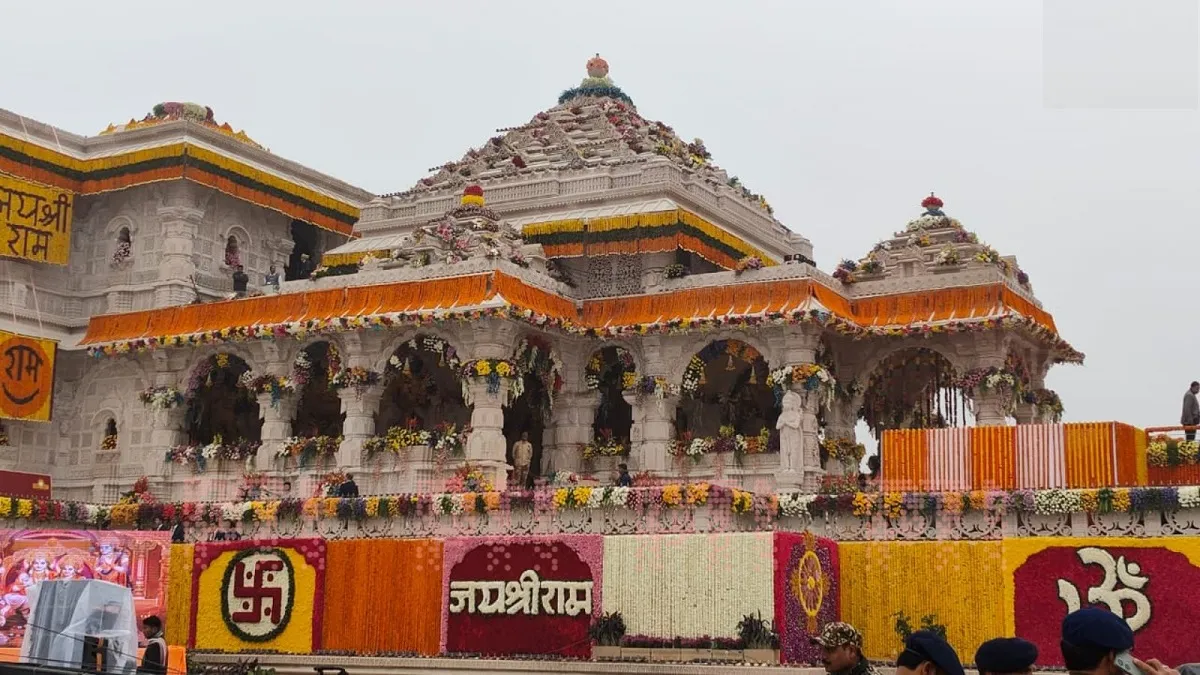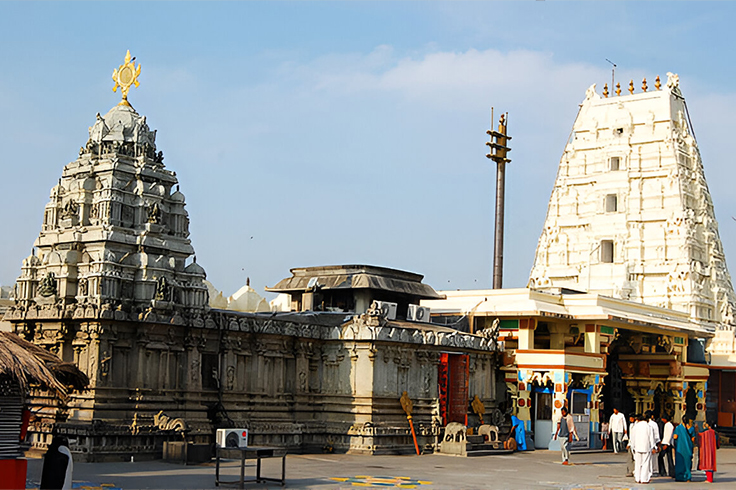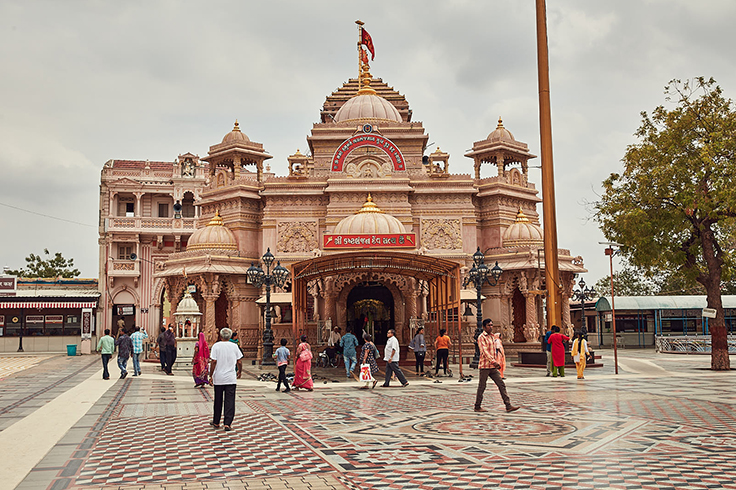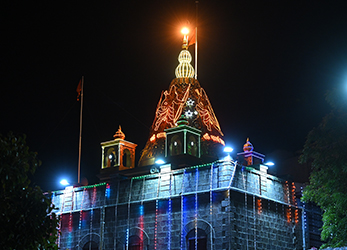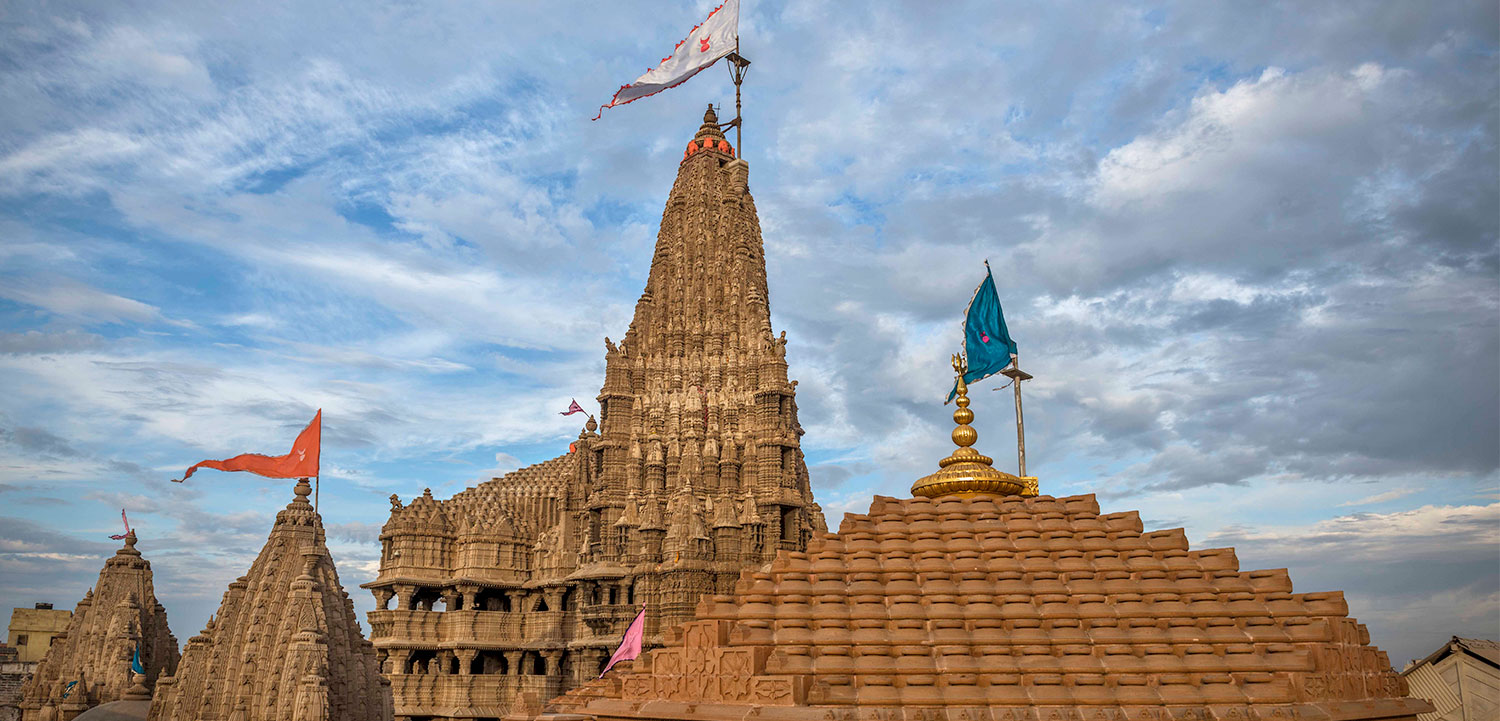Ram Raksha Stotra Lyrics in English
Viniyogah
Asya Shree Raama Rakshaa Stotra Mantrasya
Budhakaushika Rishih
Shree Seetaa Raamachandro Devataa
Anushtup Chhandah
Seetaa Shaktih Shreemaan Hanumaan Keelakam
Shree Raamachandra Preetyarthe Raama Rakshaa Stotra Jape Viniyogah ।
Dhyaanam
Dhyaayedaa Jaanubaahum Dhritashara Dhanusham Baddha Padmaasanastham
Peetam Vaaso Vasaanam Nava Kamaladala Spardhinetram Prasannam ।
Vaamaankaarudha Seetaa Mukhakamala Milallochanam Neeradaabham
Naanaalankaara Deeptam Dadhatamuru Jataamandalam Raamachandram ।
Stotram
Charitam Raghunaathasya Shatakoti Pravistaram ।
Ekaikamaksharam Punsaam Mahaapaataka Naashanam ॥1॥
Dhyaatvaa Neelotpala Shyaamam Raamam Raajeeva Lochanam ।
Jaanakee Lakshmanopetam Jataamukuta Manditam ॥2॥
Saasituna Dhanurbaana Paanim Naktam Charaantakam ।
Svaleelayaa Jagattraatumaa Virbhutamajam Vibhum ॥3॥
Raamarakshaam Pathetpraagyah Paapaghneem Sarva Kaamadaam ।
Shiro Me Raaghavah Paatu Bhaalam Dasharathaatmajah ॥4॥
Kausalyeyo Drishau Paatu Vishvaamitra Priyah Shrutee ।
Ghraanam Paatu Makhatraataa Mukham Saumitri Vatsalah ॥5॥
Jihvaam Vidyaanidhih Paatu Kantham Bharata Vanditah ।
Skandhau Divyaayudhah Paatu Bhujau Bhagnesha Kaarmukah ॥6॥
Karau Seetaapatih Paatu Hridayam Jaamadagnyajit ।
Madhyam Paatu Kharadhvansee Naabhim Jaambavadaashrayah ॥7॥
Sugreeveshah Katee Paatu Sakthinee Hanumatprabhuh ।
Uru Raghuttamah Paatu Rakshah Kulavinaasha Krit ॥8॥
Jaanunee Setukritpaatu Janghe Dashamukhaantakah ।
Paadau Vibheeshana Shreedah Paatu Raamoakhilam Vapuh ॥9॥
Etaam Raamabalo Petaam Rakshaam Yah Sukritee Pathet ।
Sa Chiraayuh Sukhee Putree Vijayee Vinayee Bhavet ॥10॥
Paataala Bhutalavyoma Chaarinashchhadma Chaarinah ।
Na Drashtumapi Shaktaaste Rakshitam Raama Naamabhih ॥11॥
Raameti Raamabhadreti Raamachandreti Vaa Smaran ।
Naro Na Lipyate Paapairbhuktim Muktim Cha Vindati ॥12॥
Jagajjaitraika Mantrena Raama Naamnaabhi Rakshitam ।
Yah Kanthe Dhaarayettasya Karasthaah Sarva Siddhayah ॥13॥
Vajrapanjara Naamedam Yo Raama Kavacham Smaret ।
Avyaahataagyah Sarvatra Labhate Jayamangalam ॥14॥
Aadishta Vaanyathaa Svapne Raama Rakshaa Mimaam Harah ।
Tathaa Likhita Vaanpraatah Prabuddho Budhakaushikah ॥15॥
Aaraamah Kalpa Vrikshaanaam Viraamah Sakalaa Padaam ।
Abhiraamastri Lokaanaam Raamah Shreemaansa Nah Prabhuh ॥16॥
Tarunau Rupa Sampannau Sukumaarau Mahaabalau ।
Pundareeka Vishaalaakshau Cheera Krishnaa Jinaambarau ॥17॥
Phalamulaashinau Daantau Taapasau Brahmachaarinau ।
Putrau Dasharatha Syaitau Bhraatarau Raama Lakshmanau ॥18॥
Sharanyau Sarva Sattvaanaam Shreshthau Sarva Dhanushmataam ।
Rakshah Kula Nihantaarau Traayetaam No Raghuttamau ॥19॥
Aattasajja Dhanushaa Vishusprishaa
Vakshayaa Shuganishanga Sanginau ।
Rakshanaaya Mama Raama Lakshmanaa
Vagratah Pathi Sadaiva Gachchhataam ॥20॥
Sannaddhah Kavachee Khadgee Chaapa Baanadharo Yuvaa ।
Gachchhan Manorathaannashcha Raamah Paatu Salakshmanah ॥21॥
Raamo Daasharathih Shuro Lakshmanaa Nucharo Balee ।
Kaakutsthah Purushah Purnah Kausalyeyo Raghuttamah ॥22॥
Vedaanta Vedyo Yagyeshah Puraana Purushottamah ।
Jaanakee Vallabhah Shreemaana Prameya Paraakramah ॥23॥
Ityetaani Japannityam Madbhaktah Shraddhayaanvitah ।
Ashvamedhaa Dhikam Punyam Sampraapnoti Na Sanshayah ॥24॥
Raamam Durvaadala Shyaamam Padmaaksham Peeta Vaasasam ।
Stuvanti Naama Bhirdivyairna Te Sansaarino Naraah ॥25॥
Raamam Lakshmana Purvajam Raghuvaram Seetaapatim Sundaram
Kaakutstham Karunaarnavam Gunanidhim Viprapriyam Dhaarmikam ।
Raajendram Satyasandham Dasharatha Tanayam Shyaamalam Shaanta Murtim
Vande Lokaabhiraamam Raghukula Tilakam Raaghavam Raavanaarim ॥26॥
Raamaaya Raamabhadraaya Raamachandraaya Vedhase ।
Raghunaathaaya Naathaaya Seetaayaah Pataye Namah ॥27॥
Shree Raama Raama Raghunandana Raama Raama
Shree Raama Raama Bharataagraja Raama Raama ।
Shree Raama Raama Ranakarkasha Raama Raama
Shree Raama Raama Sharanam Bhava Raama Raama ॥28॥
Shree Raama Chandra Charanau Manasaa Smaraami
Shree Raama Chandra Charanau Vachasaa Grinaami ।
Shree Raama Chandra Charanau Shirasaa Namaami
Shree Raama Chandra Charanau Sharanam Prapadye ॥29॥
Maataa Raamo Matpitaa Raama Chandrah
Svaamee Raamo Matsakhaa Raama Chandrah ।
Sarvasvam Me Raama Chandro Dayaalurnaanyam
Jaane Naiva Jaane Na Jaane ॥30॥
Dakshine Lakshmano Yasya Vaame Cha Janakaatmajaa ।
Purato Maarutiryasya Tam Vande Raghunandanam ॥31॥
Lokaabhiraamam Rana Rangadheeram
Raajeeva Netram Raghuvansha Naatham ।
Kaarunya Rupam Karunaakaram Tam
Shree Raama Chandram Sharanam Prapadye ॥32॥
Manojavam Maaruta Tulyavegam
Jitendriyam Buddhimataam Varishtham ।
Vaataatmajam Vaanara Yutha Mukhyam
Shree Raama Dutam Sharanam Prapadye ॥33॥
Kujantam Raama Raameti Madhuram Madhuraaksharam ।
Aaruhya Kavitaa Shaakhaam Vande Vaalmeeki Kokilam ॥34॥
Aapadaama Pahartaaram Daataaram Sarva Sampadaam ।
Lokaabhiraamam Shree Raamam Bhuyo Bhuyo Namaamyaham ॥35॥
Bharjanam Bhava Beejaanaa Marjanam Sukha Sampadaam ।
Tarjanam Yamadutaanaam Raama Raameti Garjanam ॥36॥
Raamo Raajamanih Sadaa Vijayate Raamam Ramesham Bhaje
Raamenaa Bhihataa Nishaachara Chamu Raamaaya Tasmai Namah ।
Raamaannaasti Paraayanam Parataram Raamasya Daasoasmyaham
Raame Chittalayah Sadaa Bhavatu Me Bho Raama Maamuddhara ॥37॥
Raama Raameti Raameti Rame Raame Manorame ।
Sahasranaama Tattulyam Raama Naama Varaanane ॥38॥
About Ram Raksha Stotra
Shri Ram Raksha Stotra is a Hindu devotional hymn or prayer dedicated to Lord Rama, an incarnation of the god Vishnu and a central figure in the epic Ramayana. The Ram Raksha Stotra is believed to have been composed by the sage Budha Koushika and included in the Brahmanda Purana. It is chanted or recited by devotees to seek the blessings and protection of Lord Rama. The Rama Raksha Stotra is the story of Lord Rama in verses describing Lord Rama’s attributes, qualities, and the significance of his name. Shri Ram Mantra is often recited as a form of spiritual practice or a means to invoke Lord Rama’s divine protection and guidance.
Many people believe regularly chanting Ram Raksha Stotra lyrics can bring inner peace, spiritual growth, and protection from negative influences. The word “Raksha” in the stotra’s name refers to protection, so the hymn is a prayer for divine protection from various troubles and adversities. Devotees often recite Rama Raksha Stotram during times of difficulty or when they seek Rama’s help.
The exact content and number of verses in the Sri Rama Raksha Stotram lyrics may vary slightly in different versions but its theme remains consistent – devotion to Lord Rama and a plea for his divine protection.

Historical Roots of Rama Raksha Stotram
The sage Budha Koushika, who also went by the name Valmiki, is thought to have written the Shri Ram Raksha Stotra. Valmiki was deeply moved by the character and qualities of Lord Rama, and his devotion to Ram Bhagwan inspired him to create various literary works, including the Ramayana, an epic poem that narrates the life, adventures, and virtues of Lord Rama. The Shri Ram Aarti is a spontaneous outpouring of devotion and a means for Valmiki to seek the divine protection and blessings of Bhagwan Shri Ram.
The Sri Rama Raksha Stotram is contained in the Brahmanda Purana, one of the eighteen major Puranas in Hinduism. The Brahmanda Purana contains different mythological narratives, cosmological teachings, and religious stories. Over the centuries, the Shree Ram Raksha Stotra has been transmitted through oral tradition and written manuscripts.
Significance of Rama Raksha Stotram
The Shri Ram Raksha Stotra holds immense spiritual and devotional significance for devotees of Lord Rama. Lord Rama is revered for his unwavering adherence to dharma (righteousness), exemplary character, and role as a divine protector.
It is considered a powerful prayer for divine protection and guidance. Its name, “Rama Raksha Stotra,” can be translated to “the prayer seeking Lord Rama’s protection.” Devotees believe that reciting Ram Raksha Stotra lyrics in English with dedication can help them overcome challenges, gain inner peace, and draw closer to Lord Rama. It is believed by singing Ram Ji Ke Bhajan with devotion; one can invoke the grace of Lord Rama and receive his protection from physical, mental, and spiritual challenges.
As per Bhakti Marg the Shri Ram Raksha Stotra is a devotional expression of love and reverence for Lord Rama and a means to connect with his divine grace. Many believe chanting Ram Raksha Stotra sincerely can bring spiritual benefits and divine protection.
Devotees recite the stotra to seek the divine protection and blessings of Lord Rama. They believe by singing Shri Ram Ke Bhajan with devotion, they can invoke the grace of Lord Rama and receive his protection from physical, mental, and spiritual challenges. Many people recite this stotra during times of difficulty, distress, or when they face challenges in life. It is a source of strength and solace during such moments and a way to navigate adversity with faith and courage. Devotees also turn to the Shri Ram Raksha Stotra as a means of spiritual growth. Chanting or meditating upon the stotra is a way to deepen one’s connection with Lord Rama and progress on the spiritual path.
Chanting or reciting the Ram Raksha Stotra in Hindi can be a form of meditation and mindfulness practice. It helps individuals focus their thoughts and emotions on the divine qualities of Lord Rama, promoting inner peace and mental clarity. The Shri Ram Raksha Stotra is an integral part of Hindu culture and religious practice. It is often recited during religious ceremonies, festivals, and as a daily spiritual practice. The stotra is versatile in its use. It can be chanted individually or in groups, and its recitation can be incorporated into various rituals and ceremonies.
Rama Raksha Stotram Practice and Rituals
Devotees begin with personal cleanliness by taking a bath and wearing clean clothes. This ritual cleanliness is essential before engaging in any sacred practice. They should set calm and focused mindset. Before reciting the stotra, they can take a few moments to center themselves and create a pious atmosphere.
Many devotees prefer to recite the Shri Ram Raksha Stotra in the morning after sunrise or in the evening at sunset. However, you can choose a time convenient for you. Find a quiet and peaceful place free from distractions for your practice, such as a dedicated altar or a quiet corner in your home. You may have some items on your altar or sacred space to enhance the devotional atmosphere. These may include a picture or idol of Lord Rama, a diya (oil lamp), incense, flowers, and a bell.
Begin your practice by invoking Lord Rama’s presence. You can do this by chanting the Shree Ram Mantra or prayer, such as “Om Sri Ramaya Namah” or “Om Sri Rama Jaya Rama Jaya Rama.” Start reciting the Shri Ram Raksha Stotra with commitment and concentration. You can recite it aloud or soundlessly, as you prefer. If you are new to the stotra, you can start with a smaller portion and gradually work your way to reciting the entire stotra. Some devotees choose to recite it 108 times as it is considered an auspicious number in Hindu tradition. Alternatively, you can chant it three, nine, or 27 times, based on your time and dedication.
As you recite the stotra, visualize Lord Rama in your mind’s eye. Imagine his divine form and feel his presence with you. You can also use the recitation as a form of meditation, focusing on the meaning and significance of the verses. Let the words of the stotra resonate within you, deepening your connection with Lord Rama.
After completing the recitation, you can perform Ram Bhagwan Ki Aarti (ceremonial waving of the lamp before the idol of Lord Rama) and offer flowers and incense to Lord Rama as a symbol of your devotion. Express your gratitude and make any personal prayers or requests at this time. Conclude your practice by bowing down or offering your salutations to Lord Rama. If you have a specific prayer or wish, you can offer it at that time, trusting in Lord Rama’s divine grace.
The Ram Bhagwan Ki Stuti is often recited daily or on specific occasions, depending on personal devotion and tradition. Consistent practice is believed to yield greater spiritual benefits. Over time, devotees can benefit by studying the meaning and significance of the stotra’s verses. Understanding the depth of Lord Rama Story in English can enhance your connection with Lord Rama.
The stotra is often recited in group settings, especially during festivals dedicated to Lord Rama, such as Rama Navami. Participating in communal recitation and Ram Chandra Ji Ki Aarti can be an enriching experience.
Benefits of Reciting Rama Raksha Stotram Lyrics
The Shri Ram Raksha Stotra is considered a powerful and sacred hymn in Hinduism, and its regular recitation of the different God Rama names is believed to bring various spiritual and practical benefits. The main purpose of the Shri Ram Raksha Stotra is to seek the divine protection of Lord Rama. Devotees believe that reciting Rama Raksha Stotra lyrics with faith can create a protective shield around them, guarding against physical, mental, and spiritual adversities. Chanting Shri Ram Mantra in English is believed to help remove obstacles and hurdles from one’s path, both in daily life and on the spiritual journey. It is usually recited before embarking on significant tasks or during challenging times. Many individuals turn to Rama Raksha Stotra when dealing with fear, insecurity, or uncertainty. Bhagwan Shri Ram Ke Bhajan is a source of strength and courage in challenging situations.
Regular recitation of the Rama Raksha Stotram lyrics is said to bring inner peace and tranquility. It can help calm the mind, reduce anxiety, and bring emotional stability, allowing individuals to face life’s challenges with equanimity. The rhythmic chanting of the Rama Raksha Stotram lyrics in English can have a soothing effect on the nervous system, leading to stress reduction. It can contribute to improved physical and mental health. It can promote a positive mindset, clarity of thought, and the ability to focus on one’s goals and aspirations. Reciting the stotra and chanting the different Ram Bhagwan names are believed to purify the mind and heart, helping individuals let go of negative emotions, attachments, and impurities that hinder spiritual progress.
The Shri Ram Raksha Stotra is considered a powerful tool for spiritual growth. Shri Ram Stuti deepens one’s connection with Lord Rama and aids in developing devotion, self-discipline, and self-realization. Devotees believe that by reciting the Ram Raksha Stotra in English, they invite the blessings of Lord Rama into their lives. These blessings may manifest as improved well-being, protection from harm, and guidance in making wise decisions.



